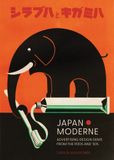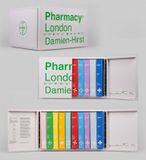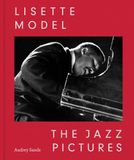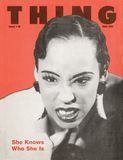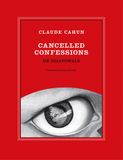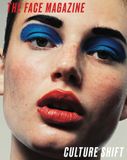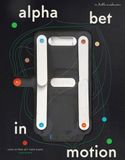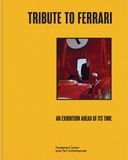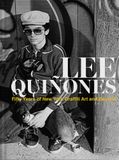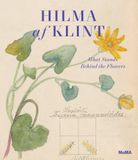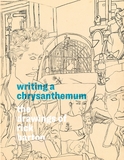| |||||||||||||||||||||||||
ARTBOOK BLOGEventsStore NewsMuseum Stores of the MonthNew Title ReleasesStaff PicksImage GalleryBooks in the MediaExcerpts & EssaysArtbook InterviewsEx LibrisAt First SightThe Artbook | D.A.P. 2025 Gift GuidesArtbook Featured Image ArchiveArtbook D.A.P. Events ArchiveDATE 1/1/2026 Happy New Year!DATE 12/25/2025 A revelation of our nation’s essential, quirky visual character in ‘Lee Friedlander: Christmas’DATE 12/16/2025 The acute gaze of Gabriele MünterDATE 12/11/2025 192 Books presents Raymond Foye and Peter Gizzi on The Song Cave's new edition of John Wiener’s 'Behind the State Capitol: Or Cincinnati Pike'DATE 12/9/2025 The atmospheric, rarely-seen watercolors of Winslow HomerDATE 12/8/2025 Pure winter glamour in ‘It’s Snowing!’DATE 12/3/2025 Flamboyant poses and melodramatic airs in 'Cecil Beaton's Fashionable World'DATE 11/30/2025 Artbook at Hauser & Wirth Los Angeles Bookstore presents Kelli Anderson and Claire L. Evans launching 'Alphabet in Motion'DATE 11/27/2025 Indigenous presence in 'Wendy Red Star: Her Dreams Are True'DATE 11/24/2025 Holiday Gift Guide 2025: Artful Crowd-PleasersDATE 11/22/2025 From 'Bottle Rocket' to 'The Phoenician Scheme' — the archives of Wes AndersonDATE 11/20/2025 The testimonial art of Reverend Joyce McDonaldDATE 11/18/2025 A profound document of art, love and friendship in ‘Paul Thek and Peter Hujar: Stay away from nothing’ | STAFF PICKS | FROM THE SHELVES
| ||||||||||||||||||||||||
STATUS: Out of print | 00/00/00 For assistance locating a copy, please see our list of recommended out of print specialists |
 Marilyn Minter: Pretty/Dirty
Marilyn Minter: Pretty/Dirty
Published by Gregory R. Miller & Co..
Text by Bill Arning, Elissa Auther, Nick Flynn, K8 Hardy, Richard Hell, Colby Keller, Eileen Myles, Jenni Sorkin, Neville Wakefield. Interview by Catherine Morris, Linda Yablonsky.
Minter’s art skews glamour with consumerist critique
PUBLISHER
Gregory R. Miller & Co.
BOOK FORMAT
Hardcover, 9.75 x 11 in. / 176 pgs / illustrated throughout.
PUBLISHING STATUS
Pub Date 5/26/2015
Out of stock indefinitely
DISTRIBUTION
D.A.P. Exclusive
Catalog: SPRING 2015 p. 46
PRODUCT DETAILS
ISBN 9781941366042 TRADE
List Price: $50.00 CAD $67.50 GBP £45.00
AVAILABILITY
Not available
STATUS: Out of stock indefinitely. |
 Studio 54
Studio 54
Published by Max Ström.
Photographs and text by Hasse Persson.
In 1977, at the height of the disco craze, a club opened at 254 West 54th Street in New York City. Studio 54 was—and, arguably, remains—the world's most renowned and legendary disco. Regularly attended by celebrities such as Andy Warhol, Elizabeth Taylor, Mick Jagger, Bianca Jagger, Jerry Hall, Debbie Harry, Grace Jones, Michael Jackson, Calvin Klein, Elton John, John Travolta, Brooke Shields and Tina Turner, the club fostered an atmosphere of unadulterated hedonism for New York's art and fashion set. Hasse Persson and his camera were frequent club guests from 1977–80. The images he photographed there have become legendary, capturing the club's famed revelers, dancers in costume and general, drunken exhilaration—and yet, incredibly, Studio 54 marks the first time in history that they have seen publication. Almost 35 years after the club's unceremonious and sudden closure, this beautiful hardback volume superbly documents the zeitgeist.
Hasse Persson (born 1942) has had a long career as a photojournalist. Though Swedish born, he spent nearly a quarter century, from 1967 to 1990, working in New York. He has published five books on America and his photographs have appeared in such publications as The New York Times, Time, Newsweek and Life. He worked as the artistic director of the Hasselblad Center in Gothenburg and today he is the artistic director of Strandverket Konsthall in Marstrand, Sweden.
PUBLISHER
Max Ström
BOOK FORMAT
Hardcover, 9.25 x 12 in. / 215 pgs / 64 bw.
PUBLISHING STATUS
Pub Date 2/24/2015
Out of stock indefinitely
DISTRIBUTION
D.A.P. Exclusive
Catalog: SPRING 2015 p. 50
PRODUCT DETAILS
ISBN 9789171263292 TRADE
List Price: $60.00 CAD $79.00
AVAILABILITY
Not available
STATUS: Out of stock indefinitely. |
 The Birth of Rock and Roll
The Birth of Rock and Roll
Published by Dust-to-Digital.
Edited with introduction by Jim Linderman. Conversation with Joe Bonomo.
In The Birth of Rock and Roll, Americana collector Jim Linderman has arranged a storyboard of sorts that dramatizes the spirit of rock and roll in its early days—when "a juke-joint with fifty patrons was a big show," as Linderman writes in his introduction. "A church with fifty congregants was a full house. The annual square dance at the town hall, a rent party, a fish-fry, the honky-tonk piano in the whore house, the union meeting … There was no real money in it. A performer was lucky to be fed, get drunk and get laid." The photographs have little to do with the conventional iconography of the birth of rock and roll: conspicuously absent are pictures of young white men in Memphis, poodle skirts, Alan Freed and Bill Haley's Brylcream. These photographs instead document and celebrate the pure but indefinable essence of rocking. Ordinary, anonymous men, women and children—some white, some black—are holding guitars and strumming while looking relaxed or frantic, but nearly always blissful. Some of the action takes place in rural fields, some in dance halls, some at civic events, some in living rooms and basements. Wherever there was an urge to make acoustic or electric music—whether to help at a rent party, busk in front of a crowd or testify in the name of Jesus—there was an uncredited photographer there to snap an image, and these are the photographs that comprise Linderman's fascinating narrative.
PUBLISHER
Dust-to-Digital
BOOK FORMAT
Hardcover, 9.75 x 12 in. / 160 pgs / 134 color.
PUBLISHING STATUS
Pub Date 4/28/2015
Active
DISTRIBUTION
D.A.P. Exclusive
Catalog: SPRING 2015 p. 62
PRODUCT DETAILS
ISBN 9780981734286 TRADE
List Price: $29.95 CAD $42.95 GBP £53.00
AVAILABILITY
In stock
in stock $29.95 Free Shipping UPS GROUND IN THE CONTINENTAL U.S. |
 Maripol: Little Red Riding Hood
Maripol: Little Red Riding Hood
Published by Damiani.
Conversation with Marc Jacobs. Text by Maripol.
When Madonna's Like a Virgin came out in 1984, it wasn't just the songs that made a splash, it was her look. That crucifix jewelry! Those earrings! Those black rubber bracelets! The accessories that gave Madonna her stylistic edge and sparked millions of prepubescent copycats across the globe were the brainchild of Maripol, a designer and stylist who was working at the time as the art director of the Fiorucci store. "I was attracted by objects and I liked to use them by taking away their original meaning," Maripol has said. "I would see something I liked and I'd say, 'That would be great as an earring.'" An habitué of the same New York dance clubs as the singer, Maripol styled Madonna at the outset of the Material Girl's career, both casually and also officially, on the Like a Virgin album cover, ensuring the singer an eternal spot in the pantheon of pop style icons. "I was already making the rubber jewelry and I was already making the crosses because of my love for the punks," she said. "So it was perfect for her." Now Maripol, who has just launched a new line of colorful, affordable accessories for Marc Jacobs, opens up her scrapbooks of drawings, designs, photography and writing to create a book that captures her personality as an artist, beginning with her childhood and her arrival in New York as a 19-year-old art school student.
Maripol moved to New York from France in 1976, where she became a part of the New York clubbing and music scene, styling Madonna and working on films such as Downtown 81 (starring Jean-Michel Basquiat and Deborah Harry). In the mid-1980s, she opened her own boutique, Maripolitan, in the NoHo area of New York. Maripol has also been art director on music videos for Cher, D'Angelo and Elton John, among others.
PUBLISHER
Damiani
BOOK FORMAT
Hardcover, 9.5 x 11.5 in. / 240 pgs / 350 color.
PUBLISHING STATUS
Pub Date 9/30/2010
Out of print
DISTRIBUTION
D.A.P. Exclusive
Catalog: FALL 2010 p. 173
PRODUCT DETAILS
ISBN 9788862081368 TRADE
List Price: $60.00 CAD $79.00
AVAILABILITY
Not available
STATUS: Out of print | 00/00/00 For assistance locating a copy, please see our list of recommended out of print specialists |
 Joseph Szabo: Rolling Stones Fans
Joseph Szabo: Rolling Stones Fans
Published by Damiani.
The Stones in '78: Szabo’s portraits of the fans
PUBLISHER
Damiani
BOOK FORMAT
Hardcover, 9.75 x 9 in. / 128 pgs / illustrated throughout.
PUBLISHING STATUS
Pub Date 5/26/2015
Active
DISTRIBUTION
D.A.P. Exclusive
Catalog: SPRING 2015 p. 48
PRODUCT DETAILS
ISBN 9788862083997 TRADE
List Price: $39.95 CAD $53.95
AVAILABILITY
In stock
in stock $39.95 Free Shipping UPS GROUND IN THE CONTINENTAL U.S. |
 Simon Barker: Punk's Dead
Simon Barker: Punk's Dead
Published by Divus.
Foreword by Simon Barker aka SIX. Text by Michael Bracewell, Damo Suzuki, Peter Tatchell, Michael Clark, Holly Woodlawn, Greil Marcus, Camila Batmanghelidjh.
From 1976 to 1978, the young photographer Simon Barker was a member of the "Bromley Contingent"--a group of avid Sex Pistols fans who comprised the group’s inner circle at the height of the punk movement. Many of them, such as Jordan and Siouxsie Sioux, were notorious for their daredevil dress sense, and several--such as Sioux, Steven Severin, Adam Ant, Poly Styrene, Billy Idol, Viv Albertine and Ari Up--went on to form some of the most important bands of the era. This compilation of previously unseen photographs by Barker shows these founders of punk in their earliest incarnations--in bedrooms and kitchens, at public gigs and private parties--before media and commerce sunk their claws into punk’s iconoclastic look and class politics. Taken with the simplest and cheapest pocket cameras, the photographs in this collection constitute Barker’s "family album for the years 1976 to 1978." In the spirit of the Pistols’ "God Save the Queen," the volume closes with a photographic sequence taken by Barker during the 1976 Jubilee celebrations, which shows Romanian tyrant Nicolae Ceausescu hobnobbing with the Queen of England in the royal procession.
PUBLISHER
Divus
BOOK FORMAT
Hardcover, 8.75 x 10.75 in. / 152 pgs / 150 color.
PUBLISHING STATUS
Pub Date 4/30/2014
Out of stock indefinitely
DISTRIBUTION
D.A.P. Exclusive
Catalog: SPRING 2014 p. 68
PRODUCT DETAILS
ISBN 9788086450650 TRADE
List Price: $45.00 CAD $60.00
AVAILABILITY
Not available
STATUS: Out of stock indefinitely. |
 Ron Galella: New York
Ron Galella: New York
Published by Damiani.
Edited by Nick Vogelson. Text by William Van Meter.
The paparazzi photography of Ron Galella has been the subject of several monographs, but this is the first volume to focus on the city with which his work is most identified--New York, in the 1970s and 80s. The book contains many unpublished images from Galella’s archives of iconic celebrities of the day, such as Bianca Jagger, Madonna, Grace Jones, Halston and Al Pacino--out and about on the streets, at JFK airport or in hotel lobbies, enjoying the nightlife and theater culture of a grittier New York City. Journalist William Van Meter interviews Galella about specific images, providing captions that reveal previously untold anecdotes about Galella’s most legendary photographs.
Ron Galella (born 1931) is widely regarded as the most famous and most controversial celebrity photographer in the world. He has been dubbed "Paparazzo Extraordinaire" by Newsweek, and "the godfather of US paparazzi culture" by Time and Vanity Fair. Galella has endured two highly publicized court battles with Jacqueline Kennedy-Onassis, a broken jaw at the hands of Marlon Brando and a serious beating by Richard Burton’s bodyguards. His work has been exhibited at museums and galleries throughout the world. The Museum of Modern Art New York and San Francisco, the Tate Modern in London and the Helmut Newton Foundation Museum of Photography in Berlin, among many others, all maintain collections of Galella’s photography. A native New Yorker now residing in Montville, New Jersey, Galella served as a United States Air Force photographer during the Korean conflict before attending the Art Center College of Design in Los Angeles, where he earned a degree in Photojournalism.
PUBLISHER
Damiani
BOOK FORMAT
Hardcover, 9 x 11 in. / 176 pgs / illustrated throughout.
PUBLISHING STATUS
Pub Date 5/31/2014
Out of stock indefinitely
DISTRIBUTION
D.A.P. Exclusive
Catalog: SPRING 2014 p. 11
PRODUCT DETAILS
ISBN 9788862083553 TRADE
List Price: $49.95 CAD $67.50
AVAILABILITY
Not available
STATUS: Out of stock indefinitely. |
|
the source for books on art & culture
CUSTOMER SERVICE
orders@artbook.com
212 627 1999 ext 202
M-F 10-6 EST
Ingram Customer Care
800-937-8200 option 3
orders@dapinc.com
NEW YORK
Showroom by Appointment Only
75 Broad Street, Suite 630
New York NY 10004
Tel 212 627 1999
LOS ANGELES
Showroom by Appointment Only
818 S. Broadway, Suite 700
Los Angeles, CA 90014
Tel. 323 969 8985
ARTBOOK LLC
D.A.P. | Distributed Art Publishers, Inc.
All site content Copyright C 2000-2025 by Distributed Art Publishers, Inc. and the respective publishers, authors, artists. For reproduction permissions, contact the copyright holders.
The D.A.P. Catalog
www.artbook.com













